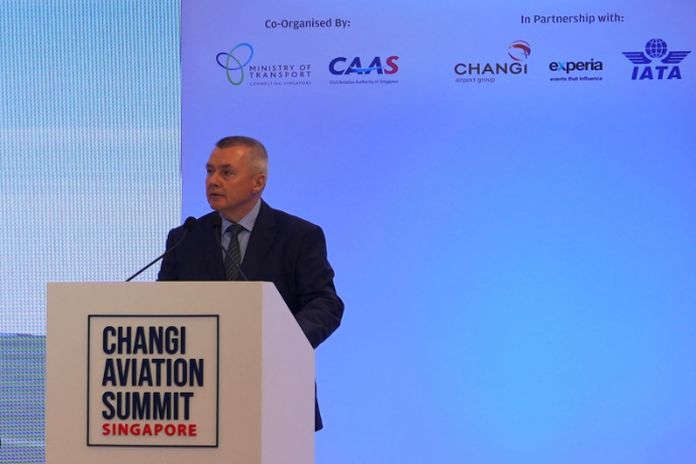By Willie Walsh
It was said at the panel discussion [last night] that to better understand the future, it’s good to understand the past and the present. And I fully agree with that. Now, I don’t intend to reflect too much on the period of the pandemic. But I just want to give you some flavour for what has happened to the industry in 2023, to look back at the shape of the industry over the past few decades, and then [to] maybe draw some conclusions as to what we think might happen going forward.
I’m pleased to say that the progress and recovery of the industry continued strongly during 2023. The full year 2023 was at just over 94 percent of where we were in 2019. And that consisted of very strong performance in domestic markets, almost 4 percent ahead of 2019, with international markets lagging at just over 88 percent.
Now if we look at this region, the situation was slightly less than that, overall at 86 percent of where the region was in 2019. The strong performance in domestic markets over 2 percent ahead, but international travel in the region still lagged behind at about 73 percent of 2019. It is important to point out that there was a strong recovery as we went through the year, moving from about 57 percent in January to almost 83 percent in December.
Looking forward, IATA estimates that over the next 20 years, the industry will grow at about 3.3 percent per annum. That is significantly lower than the growth we witnessed during 2010 to 2019. But I think it does reflect some of the challenges that we as an industry are facing and will face going into the future. Infrastructure constraints both in the air and on the ground. Supply chain issues which have now been a feature of the industry for a number of years and are likely to continue for a few more years. The delay and delivery of new aircraft, the problems in relation to engines, labour shortages in some parts of the world, and significantly the cost impact of our transition to net zero in 2050.
Because whatever way you look at this, there will be a cost associated with transitioning to net zero. And ultimately, that costs will have to be reflected in the ticket prices that we charge our customers, which will have a dampening effect on the level of growth that the industry sees going forward.
Now I’m pleased to say this region is likely to lead the markets with growth around 4.5 percent per annum during that same period.
Now, if I reflect at 1990, and I’ve chosen 1990 for a couple of reasons. It recognizes that we had the introduction of the Boeing 737-300, 400 and 500s in the mid-80s and the Airbus A320 in the late 1980s. It also reflects a fully deregulated market in the US, and a deregulated market in Europe. And it’s fascinating to look at the shape of the industry in that year.
At IATA, we look at six major geographic regions when we’re assessing our economic performance, and we report on these on a monthly basis. That’s Africa, Asia-Pacific, Europe, Latin America, Middle East and North America. In 1990, African airlines contributed 2.2 percent of global aviation. Asia-Pacific carriers were 19.7 percent, Europe 28 percent, Latin America and Caribbean 5.4 percent, Middle East carriers 2.4 percent and a lot has been written about what has happened in the Middle East. But significantly North American carriers 42 percent of the global markets.
Now if we roll forward and look at 2019, Africa continued to be at 2.1 percent. But we saw significant growth in the Asia-Pacific region, reaching almost 35 percent of the global market in 2019. Europe remained pretty static at 27 percent, Latin America 5 percent, the Middle East has grown from 2.4 percent to 9.1 percent, and North American carriers had reduced from 42 percent to just over 22 percent.
The figures for 2023 are broadly similar. Asia Pacific, reflecting the fact that the recovery has been slightly slower in international markets at about 32 percent.
Now, it’s interesting also to reflect on the fact that if I look at the major domestic markets, the domestic market in China in 1990 was just over 1 percent of all global activity, and India about 0.2 percent. Looking forward at 2023, the Chinese domestic market now represents over 11 percent, of total commercial aviation, and India has grown to almost 1.8 percent. We’ve seen significant growth in these markets in that period. And I think when you look at the demographics of the world, it doesn’t take much to imagine what is going to happen in these countries going forward, particularly in India, which I think represents a fantastic opportunity for the industry.
I think it is disappointing for us to reflect on the fact that Africa remains in the doldrums at just over 2 percent. I think the potential for growth in Africa is huge. But there has to be change to enable consumers in the African region to take advantage of the opportunities that aviation provides.
We also looked at major route groups. The top 20 route groups account for about 95 percent of all international travel. I’m not going to go through them all but just to reflect that in 2019, before the pandemic, the Asia-Pacific region was at number two, with 13.3 percent. The biggest international market was Western Europe. International travel within Europe at 18 percent, and Europe to North America represented 11.4 percent.
In 2023, and this demonstrates why we’ve seen a lag in the recovery in Asia-Pacific, international travel within the Asia-Pacific region had fallen to 9.7 percent. So, this is a huge opportunity for continuing recovery in the market here and I’m excited about what things are going to look like in the years ahead.
Now, a lot has been said about the challenges we face. And some of these will be discussed in the panel. But, I just want to comment briefly on the environment.
This industry is absolutely committed to achieving net zero CO2 in 2050. And we cannot fail or falter in our efforts to achieve that goal. It is absolutely essential that we work together to ensure that we can credibly provide people with confidence that we have a pathway to decarbonize our industry. And I think we can take a lot of confidence from what we’ve achieved already. And we’ve talked about this in many different forums.
But just to give you one figure. If you look at the CO2 produced by the industry in 2000, and compare that to what we did in 2019 just before the pandemic, our CO2 footprint increased by almost 54 percent. But during that same period, passenger traffic grew by 175 percent. So, there is complete disconnect between passenger growth and our C02 growth. So, we know that we can be confident that with the measures we’ve put in place, with the advances in new technology, there are opportunities for us to address this critical issue. But as the minister said, central to achieving our goal will be the use of sustainable aviation fuel. For us, this is the most important issue in the short to medium term.
Now I believe the industry has shown strong demand for this product. Every single drop of sustainable aviation fuel that has been produced has been used by the industry. In 2020, 2021, 2022, during the height of the pandemic, the industry continued to invest in this expensive product. And, I’ve absolutely no doubt that we will continue to do so. What we need to see as an industry is greater production. We need to see governments providing the incentive for production to significantly increase. And with that increase in production, I guarantee you that the airlines will use all of the fuel produced despite the cost impact that will represent.
Technology, labour issues, all of these are fascinating opportunities for the industry going forward. But as I stand and look at the future of this industry, I’m very confident that we can overcome all of the challenges that we’re likely to face. We can take confidence in our ability to overcome some significant challenges in recent times. And, working together, with the right policy frameworks in place from governments, the industry has a very credible path to achieving all of the necessary measures to ensure that we are net zero in 2050.







